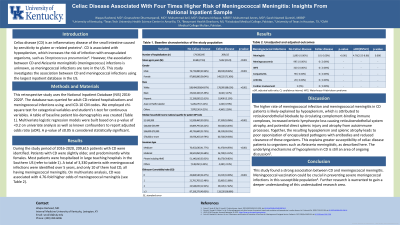Monday Poster Session
Category: Small Intestine
P2643 - Celiac Disease Associated With Four Times Higher Risk of Meningococcal Meningitis: Insights From National Inpatient Sample
Monday, October 23, 2023
10:30 AM - 4:15 PM PT
Location: Exhibit Hall

Has Audio

Waqas Rasheed, MD
Texas Tech University Health Sciences Center
Lexington, KY
Presenting Author(s)
Waqas Rasheed, MD1, Gnanashree Dharmarpandi, MD1, Muhammad Anil, MD2, Shahana ishfaque, MBBS3, Muhammad Anees, MD1, Sarah Naveed. Qureshi, MBBS4
1Texas Tech University Health Sciences Center, Amarillo, TX; 2Beaumont Hospital, Dearborn, MI; 3Punjab Medical College, Faisalabad, Pakistan, Dearborn, MI; 4CMH Multan Institute of Medical Sciences, Multan, Pakistan, Beaumont, TX
Introduction: Celiac disease (CD) is an inflammatory disease of the small intestine caused by sensitivity to gluten or related proteins. CD is associated with hyposplenism, which increases the risk of infection with encapsulated organisms, such as pneumococcus. However, the association between CD and meningococcal infections is unknown, so this study was done to address this knowledge gap.
Methods: This retrospective study uses the National Inpatient Database (NIS) 2016-2020 and ICD-10 CM codes. The database is queried for adult CD-related hospitalizations and meningococcal infections, and a chi-square test is used for categorical variables and a student's t-test for continuous variables. A table of baseline patient biodemographic, hospital characteristics and meningococcal infections is created (Table 1). Multivariate logistic regression models are built based on a P-value of < 0.2 on univariate analysis and known confounders. A P-value of ≤0.05 is considered statistically significant.
Results: During the study period of 2016-2020, 209,615 patients with CD were identified. Patients with CD were slightly older, and there was a higher predominance of females and the white race. Most patients were hospitalized in large teaching hospitals in the Southern US. A total of 3,330 patients with meningococcal infections were identified over 5 years, and only 10 of them had CD, all having meningococcal meningitis. On multivariate analysis, CD was associated with 2.94-fold higher odds of meningococcal infections and 4.76-fold higher odds of meningococcal meningitis (Table 1).
Discussion: The higher rate of meningococcal infection and meningococcal meningitis in CD patients is likely explained by hyposplenism, which is attributed to reticuloendothelial blockade by circulating complement-binding immune complexes, increased enteric lymphocyte loss causing reticuloendothelial system atrophy, and potential direct splenic injury and atrophy from autoimmune processes. Together, the resulting hyposplenism and splenic atrophy leads to poor opsonization of encapsulated pathogens with antibodies and reduced clearance of these organisms. This explains greater susceptibility of celiac disease patients to organisms such as Neisseria meningitidis, as described here. The underlying mechanisms of hyposplenism in CD is still an area of ongoing discussion and further research is necessary.
Disclosures:
Waqas Rasheed, MD1, Gnanashree Dharmarpandi, MD1, Muhammad Anil, MD2, Shahana ishfaque, MBBS3, Muhammad Anees, MD1, Sarah Naveed. Qureshi, MBBS4. P2643 - Celiac Disease Associated With Four Times Higher Risk of Meningococcal Meningitis: Insights From National Inpatient Sample, ACG 2023 Annual Scientific Meeting Abstracts. Vancouver, BC, Canada: American College of Gastroenterology.
1Texas Tech University Health Sciences Center, Amarillo, TX; 2Beaumont Hospital, Dearborn, MI; 3Punjab Medical College, Faisalabad, Pakistan, Dearborn, MI; 4CMH Multan Institute of Medical Sciences, Multan, Pakistan, Beaumont, TX
Introduction: Celiac disease (CD) is an inflammatory disease of the small intestine caused by sensitivity to gluten or related proteins. CD is associated with hyposplenism, which increases the risk of infection with encapsulated organisms, such as pneumococcus. However, the association between CD and meningococcal infections is unknown, so this study was done to address this knowledge gap.
Methods: This retrospective study uses the National Inpatient Database (NIS) 2016-2020 and ICD-10 CM codes. The database is queried for adult CD-related hospitalizations and meningococcal infections, and a chi-square test is used for categorical variables and a student's t-test for continuous variables. A table of baseline patient biodemographic, hospital characteristics and meningococcal infections is created (Table 1). Multivariate logistic regression models are built based on a P-value of < 0.2 on univariate analysis and known confounders. A P-value of ≤0.05 is considered statistically significant.
Results: During the study period of 2016-2020, 209,615 patients with CD were identified. Patients with CD were slightly older, and there was a higher predominance of females and the white race. Most patients were hospitalized in large teaching hospitals in the Southern US. A total of 3,330 patients with meningococcal infections were identified over 5 years, and only 10 of them had CD, all having meningococcal meningitis. On multivariate analysis, CD was associated with 2.94-fold higher odds of meningococcal infections and 4.76-fold higher odds of meningococcal meningitis (Table 1).
Discussion: The higher rate of meningococcal infection and meningococcal meningitis in CD patients is likely explained by hyposplenism, which is attributed to reticuloendothelial blockade by circulating complement-binding immune complexes, increased enteric lymphocyte loss causing reticuloendothelial system atrophy, and potential direct splenic injury and atrophy from autoimmune processes. Together, the resulting hyposplenism and splenic atrophy leads to poor opsonization of encapsulated pathogens with antibodies and reduced clearance of these organisms. This explains greater susceptibility of celiac disease patients to organisms such as Neisseria meningitidis, as described here. The underlying mechanisms of hyposplenism in CD is still an area of ongoing discussion and further research is necessary.
Disclosures:
Waqas Rasheed indicated no relevant financial relationships.
Gnanashree Dharmarpandi indicated no relevant financial relationships.
Muhammad Anil indicated no relevant financial relationships.
Shahana ishfaque indicated no relevant financial relationships.
Muhammad Anees indicated no relevant financial relationships.
Sarah Qureshi indicated no relevant financial relationships.
Waqas Rasheed, MD1, Gnanashree Dharmarpandi, MD1, Muhammad Anil, MD2, Shahana ishfaque, MBBS3, Muhammad Anees, MD1, Sarah Naveed. Qureshi, MBBS4. P2643 - Celiac Disease Associated With Four Times Higher Risk of Meningococcal Meningitis: Insights From National Inpatient Sample, ACG 2023 Annual Scientific Meeting Abstracts. Vancouver, BC, Canada: American College of Gastroenterology.
